In the present paper we propose a simple time-varying ODE model to describe the evolution of HIV epidemic in Italy. The model considers a single population of susceptibles, without distinction of high-risk groups within the general population, and accounts for the presence of immigration and emigration, modelling their effects on both the general demography and the dynamics of the infected subpopulations. To represent the intra-host disease progression, the untreated infected population is distributed over four compartments in cascade according to the CD4 counts. A further compartment is added to represent infected people under antiretroviral therapy. The per capita exit rate from treatment, due to voluntary interruption or failure of therapy, is assumed variable with time. The values of the model parameters not reported in the literature are assessed by fitting available epidemiological data over the decade 2003÷2012. Predictions until year 2025 are computed, enlightening the impact on the public health of the early initiation of the antiretroviral therapy. The benefits of this change in the treatment eligibility consist in reducing the HIV incidence rate, the rate of new AIDS cases, and the rate of death from AIDS. Analytical results about properties of the model in its time-invariant form are provided, in particular the global stability of the equilibrium points is established either in the absence and in the presence of infected among immigrants.
1.
Introduction
In the last decades stochastic optimal control theory has received an increasing attention by the mathematical community, also in connection with several concrete applications, spanning from industry to finance, from biology to crowd dyamics, etc. In all of above applications a rigorous theory of stochastic optimal control (SOC), under suitable assumption on the source of random noise, revealed to be a fundamental point.
To this aim different theoretical approaches have been developed. They can be broadly divided into two classes: partial differential equations (PDE) methods via the Hamilton-Jacobi-Bellman (HJB) equation, and methods based on the maximum principle via backward stochastic differential equations (BSDEs), see, e.g., [12,24,27]
In particular BSDEs' methods have proved to be particularly adapted for a large set of SOC-problems, as reported, e.g., in [25]. Within previously mentioned problems a particular role is played by those SOC problems characterized by the specification of a random terminal time. In particular, this a classical task in Finance at least since the recent financial credit crunch which imposed the need to model possible defaults and credit risks. When dealing with optimal control with random terminal time, two main approaches are possible. The first possible setting considers the random terminal time as a to be completely inaccessible to the reference filtration. The related classical approach consists in enlarging the reference filtration, see, e.g., [20]. In this way, via a suitable density assumption on the conditional law of the random time, the original problem is converted into a control problem with fixed terminal time, with respect to the new enlarged filtration, see, e.g., [11,23] for more theoretical insights and to [2,3,5,18] for some concrete applications.
A second, alternative, approach assumes that the stopping times are accessible from the reference filtration, hence implying a perfect information about the triggered random times. The typical assumption in this setting is that the stopping time τ is defined as the first hitting time of a barrier v for a reference system whose dynamic is given by a stochastic differential equation (SDE). In a credit risk setting, such an approach is known as the structural approach, and it has a long-standing financial literature whose first results date back to [21]. It is worth stressing that this last scenario does not fall back into previous one, where inaccessible stopping times are considered. In fact, if the stopping time is to be defined as the first hitting time, it does not satisfy above mention density hypothesis.
The present paper investigates a SOC-problem with multiple random events of the latter type. Therefore, differently from [18,23], we will not assume random events to be totally inaccessible, but, instead, they will be defined as first hitting time, against a predetermined boundary, of the driving process.
In particular, we will consider a controlled system of n∈N SDEs of the general form
under standard assumptions of Lipschitz coefficients μi and σi with at most linear growth, being αi the control. The notation will be specified in detail within subsequent sections.
We aim at minimizing the following functional up to a given stopping time τ,
for some suitable functions L and G, where we have denoted by X(t)=(X1(t),…,Xn(t)) and α(t)=(α1(t),…,αn(t)).
Then we assume that the system, instead of being stopped as soon as the stopping time τ is triggered, continues to evolve according to a new system of SDEs written as follows
for some new coefficients μi1 and σi1 again satisfying standard assumptions of linear growth and Lipschitz continuity. In particular, we will assume that, according to the triggered stopping time the k−th component in Eq (1) has been set to 0, according to rigorous definitions later specified. Then, we again aim at minimizing a functional of the form
with the same notation used before, τ1 being a new stopping time. We repeat such a scheme for a series of n stopping times. Moreover, in complete generality, we assume that the order of the random times is not know a priori, hence forcing us to consider all possible combinations of random events with associated all the possible combinations of driving SDEs.
The main result of the present paper consists in deriving a stochastic maximum principle, both in necessary and sufficient form, for the whole series of control problems stated above. To the best of our knowledge this is the first work that derives a maximum principle for a series of interconnected optimal problem. The maximum principle can in turn help in deriving a closed–loop optimal control problem. This will be further showed into the work for the relevant case of a linear–quadratic optimal control problem whose closed-form solution is of affine form.
Clearly, we cannot expect that the global optimal solution is given by gluing each optimal control between two consecutive stopping times. Instead, we will tackle the problem following a dynamic programming principle approach, as exploited, e.g., in [23]. In particular, we will solve the problem backward. Therefore, the case of all stopping times but one have been triggered is considered first, then we consider the problem with two random events left, etc., until the very first control problem. Following this scheme, we are able to provide the global optimal solution recursively, so that the k−th optimal control problem depends on the (k+1)−th optimal solution. We remark that altough the backward approach has been used in literature, see, e.g., [18,23], to the best of our knowledge the present work is the first one using such techniques where stopping times are defined as hitting times.
After having derived the main result, i.e., the aforementioned maximum principle, we will consider the particular case of a linear–quadratic control problem, that is we assume the underlying dynamics to be linear in both the state variable and the control, with quadratic costs to be minimized. Such type of problems have been widely studied both from a theoretical and practical point of view since they often allow to obtain closed form solution for the optimal control.
In particular, usually one can write the solution to a linear–quadratic control problem in terms of the solution of a Riccati backward ordinary differential equation (ODE), hence reducing the original linear–quadratic stochastic control problem to the solution of a simpler ODE, see, e.g., [27] and [24,Section 6.6], for possible financial applications. Let us recall that, considering either random coefficients for the driving equation or random terminal time in the control problem, the latter case being the one here treated, the backward Riccati ODE becomes a Riccati BSDE, see, e.g., [13,14,16,17].
We stress that the results derived in the present paper find natural applications in many areas related to mathematical finance, and mainly related to systemic risk, where after recent credit crisis, the assumption of possible failures has become the main ingredient in many robust financial models. Also, network models have seen an increasing mathematical attention during last years, as witnessed by the development of several ad hoc techniques derived to consider general dynamics on networks. We refer the interested reader to [6,7,9], for general results on network models, and to [15] for a financially oriented treatment.
In particular, these models have proved to be particularly suitable if one is to consider a system of interconnected banks. Following thus the approach of [4,10,19], results derived in the present work can be successfully applied to a system of n interconnected banks, lending and borrowing money. As in [4,8] one can assume the presence of an external controller, typically called lender of last resort (LOLR), who actively supervises the banks' system and possibly lending money to actors in needs. A standard assumption is that the LOLR lends money in order to optimize a given quadratic functional. Therefore, modelling the system as in [8], we recover a linear–quadratic setting allowing us to apply results obtained in the present work.
The paper is organized as follows: In Section 2 we introduce the general setting, clarifying main assumptions; then, Section 2.1 is devoted to the proof of the necessary maximum principle, whereas in Section 2.2 we will prove the sufficient maxim principle; at last, in Section 3, we apply previous results to the case of a linear–quadratic control problems also deriving the global solution by an iterative scheme to solve a system of Riccati BSDEs.
2.
The general setting
Let n∈N and T<∞ a fixed terminal time and let us consider a standard complete filtered probability space (Ω,F,(Ft)t∈[0,T],P) satisfying usual assumptions.
In what follows we are going to consider a controlled system of n SDEs, for t∈[0,T] and i=1,…,n, evolvong has folllows
where Wi(t) is a standard Brownian motion, αi;0 being the control. In particular, we assume
where Ai⊂R is assumed to be convex and closed, and we have denoted by L2ad([0,T];R) the space of (Ft)t∈[0,T]–adapted processes α such that
while A:=⊗ni=1Ai.
In what follows we will assume the following assumptions to hold.
Assumptions 2.1. Let μ:[0,T]×R×A→R and σ:[0,T]×R×A→R be measurable functions and suppose that there exits a constant C>0 such that, for any x, y∈R, for any a∈A and for any t∈[0,T], it holds
We thus assume the coefficients μi;0 and σi;0, for i=1,…,n, in Eq (2), satisfy assumptions 2.1. Thererfore, we have that there exists a unique strong solution to Eq (2), see, e.g., [12,24].
Remark 2.2. In Eq (2) we have considered an R−valued SDE, nevertheless what follows still holds if we consider a system of SDEs, each of which takes values in Rmi, mi∈N, i=1,…,n.
Let us denote by
then define the coefficients
as
and
that is the matrix with σi;0(t,x,a) entry on the diagonal and null off-diagonal.
Let us also denote x00=(x1;00,…,xn;00) and W(t)=(W1(t),…,Wn(t))T. Hence, system (2) can be compactly rewritten as follows
We will minimize the following functional
where L0 and G0 are assumed to satisfy the following assumptions:
Assumptions 2.3. Let L0:[0,T]×Rn×A0→R and G0:[0,T]×Rn→R be two measurable and continuous functions such that there exist two constants K, k>0 such that, for any t∈[0,T], x∈Rn and a∈A0, it holds
Let us underline that in the cost functional defined by (4), the terminal time ˆτ1 is assumed to be triggered as soon as X0 reaches a given boundary v0. In particular, we assume the stopping boundary to be of the form
for some given constants vi;0∈R, i=1,…,n. We thus denote by
the first time Xi;0 reaches the boundary vi;0 and we set
the first stopping time to happen.
We stress that, in what follows we will denote by ˆτ the ordered stopping times. In particular, ˆτ1≤⋯≤ˆτn, where ˆτk denotes the k−th stopping time to happen. On the contrary, the notation τk indicates that the stopping time has been triggered by the k-th node. In what follows, we will use the convention that, if ˆτ1=τk, then τj=T, for j≠k.
Remark 2.4. From a practical point of view, we are considering a controller that aims at supervise n different elements defining a system, up to the first time one of the element of it exits from a given domain. From a financial perspective, each element represents a financial agent, while the stopping time denotes its failure time. Hence, a possible cost to be optimized, as we shall see in Section 3, is to maximize the distance between the element/financial agent from the associated stopping/default boundary.
As briefly mentioned in the introduction, instead of stopping the overall control problem when the first stopping time is triggered, we assume that the system continues to evolve according to a (possibly) new dynamic. As to make an example, let us consider the case of ˆτ1≡ˆτk;0, that is the first process to hit the stopping boundary is Xk;0. We thus set to 0 the k−th component of X0, then considering the new process
with control given by
where the superscript k denotes that the k−th component hit the stopping boundary and therefore has been set to 0.
Then, we consider the n−dimensional system, for t∈[ˆτ1,T], defined by
where the coefficients μi;k and σi;k satisfy assumptions 2.1 and we have also set Xk;k(t)=0.
We therefore define Bk:[ˆτ1,T]×Rn×A→Rn and Σk:[ˆτ1,T]×Rn×A→Rn×n as
which allows us to rewrite the above system as
where Φk is the diagonal n×n matrix defined as
the null-entry being in the k−th position.
Then we minimize the following functional
where Lk and Gk are assumed to satisfy assumptions 2.3, while ˆτ2 is a stopping time triggered as soon as Xk hits a defined boundary. In particular, we define the stopping boundary
and, following the same scheme as before, we define by
the first time Xi;k reaches the boundary vi;k, denoting
It follows that, considering for instance the case τl;k has been triggered by Xl;k, we have ˆτ2≡ˆτl;k, meaning that vl;k has been hit. Iteratively proceeding, we consequently define
again assuming X(k,l)(t) evolves according to a system as in (3), and so on until either no nodes are left or the terminal time T is reached.
As mentioned above, one of the major novelty of the present work consists in not assuming the knowledge of the stopping times order. From a mathematical point of view, the latter implies that we have to consider all the possible combinations of such critical points during a given time interval [0,T]. Let us note that this is in fact the natural setting to work with having in mind the modelling of concrete scenarios, as happens, e.g., concerning possible multiple failures happening within a system of interconnected banks.
Therefore, in what follows we are going to denote by Cn,k the combinations of k elements from a set of n, while πk∈Cn,k stands for one of those element. Hence, exploiting the notation introduced above, we define the process X=(X(t))t∈[0,T] as
where each Xπk(t) is defined as above and, consequently, the the global control reads as follow
Remark 2.5. Let us underlined within the setting defined so far, each stopping time ˆτk depends on previously triggered stopping times τπj, j=1,…,k−1. As a consequence, also the solution Xπk in (7) depends on triggered stopping times as well as on their order. To simplify notation, we have avoided to explicitly write such dependencies, defining for short
By Eq (7) we have that the dynamic for X is given by
where, according to the above introduced notation, we have defined
aiming at minimizing the following functional
L and G being defined as
Remark 2.6. It is worth to mention that we are considering the sums stated above as to be done over all possible combinations, hence implying we are not considering components' order, namely considering X(k,l)=X(l,k). Dropping such an assumption implies that the sums in Eqs (7), (8) and (10) have to be considered over the disposition Dn,k.
In what follows we shall give an example of the theory developed so far, as to better clarify our approach as well as its concrete applicability.
Example 2.1. Let us consider the case of a system constituted by just n=2 components. Then Eq (7) becomes
where X0(t), resp. X1(t), resp. X2(t), denotes the dynamics in case neither 1 nor 2 has hit the stopping boundary, resp. 1 has, resp. 2 has.
Then, denoting by α0(t), α1(t) and α2(t) the respective associated controls, we have that the functional (11) reads
2.1. A necessary maximum principle
The main issue in solving the optimal control problem defined in Section 2 consists in solving a series of connected optimal problems, each of which may depends on previous ones. Moreover, we do not assume to have an a priori knowledge about the stopping times' order.
To overcome such issues, we consider a backward approach. In particular, we first solve the last control problem, then proceeding with the penultimate, and so on, until the first one, via backward induction. Let us underline that assuming the perfect knowledge of the stopping times' order would imply a simplification of the backward scheme, because of the need to solve only n control problems, then saving us to take into account all the combinations. Nevertheless in one case as in the other, the backward procedure runs analogously.
Aiming at deriving a global maximum principle, in what follows we denote by ∂x the partial derivative w.r.t. the space variable x∈Rn and by ∂a the partial derivative w.r.t. the control a∈An. Moreover we assume
Assumptions 2.7. (ⅰ) For any πk∈Cn,k, k=1,…,n, it holds that Bπk and Σπk are continuously differentiable w.r.t. to both x∈Rn and to a∈A. Furthermore, there exists a constant C1>0 such that for any t∈[0,T], x∈Rn and a∈A, it holds
(ⅱ) For any πk∈Cn,k, k=1,…,n, it holds that Lπk, resp. Gπk, is continuously differentiable w.r.t. to both x∈Rn and a∈An, resp. only w.r.t. x∈Rn. Furthermore, there exists a constant C2>0 such that for any t∈[0,T], x∈Rn and a∈An, it holds
We thus have the following result.
Theorem 2.8. [Necessary Maximum Principle] Let assumptions 2.1–2.3–2.7 hold and let (ˉX,ˉα) be an optimal pair for the problem (9)–(11), then it holds
equivalently
where the pair (Y(t),Z(t)) solves the following dual backward equation
the pairs (Yπk(t),Zπk(t)) being solutions of the following system of interconnected BSDEs
having denoted by
where Hπk is the generalized Hamiltonian
defined as
and H represents the global generalized Hamiltonian defined as
Remark 2.9. Before entering into details about proving Theorem 2.8, let us underline some of its characteristics. In particular, here the main idea is to find a solution iteratively acting backward in time. Therefore, starting from the very last control problem, namely the case where a single node is left into the system, we consider a standard maximum principle. Indeed, Yπn−1 in (13) represents a classical dual BSDE form associated to the standard stochastic maximum principle, see, e.g., [27,Th. 3.2]. Then, we can consider the second last control problem. A this point, a naive tentative to obtain a global solution, could be to first solve such penultimate problem to then gluing together the obtained solutions. Nevertheless, such a method only produces a a suboptimal solution. Instead, the right approach, similarly to what happens applying the standard dynamic programming principle, consists in treating the solution to the last control problem as the terminal cost for the subsequent (second last) control problem, and so on for the remaining ones.
It follows that, in deriving the global optimal solution, one considers the cost coming from future evolution of the system. Mathematically, this is clearly expressed by the terminal condition Yπk the Eq (13) is endowed with. Therefore the solution scheme resulting in a global connection of all the control problems we have to consider, from the very last of them and then backward to the first one.
Proof. [Necessary Maximum Principle.] We proceed according to a backward induction technique. In particular,
for t0>ˆτn−1 the proof follows from the standard stochastic necessary maximum principle, see, e.g., [27,Th. 3.2]. Then we consider the case of ˆτn−2<t0<ˆτn−1, and we define
to be the optimal control, α being another admissible control and further setting αh as
Since in the present case the cost functional reads as follow
we can choose α=ˉα−˜α, ˜α∈A. Then, by the optimality of ˉα and via a standard variational argument, see, e.g., [1,22,27], we have
which implies
In what follows, for the sake of clarity, we will denote by Xα the solution X with control α. Thus, from the optimality of ˉα, we have
Then, for any α∈A, by (15), we obtain
where Zπn−1 and Zπn−2 solve the first variation process
Applying Itô formula to Yπn−2⋅Zπn−2, we have
and similarly for Yπn−1⋅Zπn−1, we obtain
Exploiting Eq (16), together with Eqs (17) and (18), we thus have
for all α=ˉα−˜α, and thus we eventually obtain, for t0>ˆτn−2
which is the desired local form for optimality (12). Analogously proceeding via backward induction, we derive that the same results also hold for any πk∈Cn,k, hence obtaining the system (13) and concluding the proof.
2.2. A sufficient maximum principle
In this section we consider a generalization of the classical sufficient maximum principle, see, e.g., [24,Th. 6.4.6], for the present setting of interconnected multiple optimal control problems with random terminal time. To this end, we assume
Assumptions 2.10. For any πk∈Cn,k the derivative w.r.t. x of B, Σ and L are continuous and there exists a constant La>0 such that, for any a1, a2∈A,
Theorem 2.11 (Sufficient maximum principle). Let 2.1–2.3–2.7–2.10 hold, let (Y,Z) be the solution to the dual BSDE 13, and suppose the following conditions hold true
(ⅰ) the maps x↦Gπk(x) are convex for any πk;
(ⅱ) the maps (x,a)↦Hπk(x,a,Yπk,Zπk) are convex for a.e. t∈[0,T] and for any πk;
(ⅲ) for a.e. t∈[0,T] and P−a.s. it holds
then (ˉα,ˉX) is an optimal pair for the problem (9)–(11).
Proof. Let us proceed as in the proof of Theorem 2.8, namely via backward induction. For t0>ˆτn−1 the proof follows from the standard sufficient stochastic maximum principle, see, e.g., [27,Th. 5.2].
Let us thus then consider the case of ˆτn−2<t0<ˆτn−1, denoting by ΔXπk(t):=ˉXπk(t)−Xπk(t) and, for the sake of clarity, by using similar notations for any other function.
The convexity of Gπn−1, together with the terminal condition
yields
Applying the Itô-formula to ΔXπn−1Yπn−1(ˆτn), we obtain
Similarly, from the convexity of the Hamiltonian, we also have
so that, for any πn−1, by combining Eqs (19)–(21), we derive
Analogously, for t0∈[ˆτn−2,ˆτn−1], and since
together with the convexity of Gπn−2, we have
Similar computations also give us
so that, for t0∈[ˆτn−2,ˆτn−1], by Eqs (22) and (23), we infer that
which implies that
and the optimality of (ˉα,ˉX).
Proceeding backward, previously exploited arguments allow us to show the same results for any πk∈Cn,k, hence ending the proof.
3.
The linear–quadratic problem
In the present section we consider a particular case for the control problem stated in Sections 2.1 and 2.2. In particular, we will assume that the dynamic of the state equation is linear in both the space and the control variable. Moreover, we impose that the control enters (linearly) only in the drift and that the cost functional is quadratic and of a specific form. More precisely, let us first consider μ0(t) as the n×n matrix defined as follows
that is the matrix with μi;0(t) entry on the diagonal and null off-diagonal, μi;0:[0,T]→R being a deterministic and bounded function of the time. Also let
where again bi;0:[0,T]→R is a deterministic and bounded function of time. Then we set
Let us also define the n×n matrix Σ0, to be independent of the control, as follows
σi;0, νi;0:[0,T]→R being deterministic and bounded function of time.
Same assumptions of linearity holds for any other coefficients Bπk and Σπk, so that, using the same notation introduced along previous sections, we consider the system
where both the drift and the volatility coefficients are now assumed to be linear. In the present (particular) setting, both the running and the terminal cost are assumed to be suitable quadratic weighted averages of the distance from the stopping boundaries, namely we set
for some given weights γπk such that
Remark 3.1. From a financial perspective, converting the minimization problem into a maximization one, the above cost functional can be seen as a financial supervisor, such as the one introduced in [4,8], aiming at lending money to each node (e.g., a bank, a financial player, an institution, etc.) in the system to avert it from the corresponding (default) boundary. Continuing the financial interpretation, different weights γ can be used to assign to any node a relative importance. This allows to establish a hierarchy of (financial) relevance within the system, resulting in a priority scale related to the systemic (monetary) importance took on by each node. As to give an example, in [8] a systematic procedure has been derived to obtain the overall importance of any node in a financial network.
In what follows, we derive a set of Riccati BSDEs to provide the global optimal control in feedback form. For the sake of notation clarity, we denote by Xk;−k(t) the dynamics when only the k−th node is left. Similarly, Xk;−(k,l)(t), resp. Xl;−(k,l)(t), denotes the evolution of the node k, resp. of the node l, when this pair (k,l) survives. Analogously, we will make use of a component-wise notation, namely Xi;−k will denote the i−th component of the n−dimensional vector X−k. According to such a notation, we have the following
Theorem 3.2. The optimal control problem (27), with associated costs given by (28), has an optimal feedback control solution given by
where P and φ are defined as follows
Pπk and φπk being solution to the following recursive system of Riccati BSDEs
Proof. Let us thus first consider the last control problem, recalling that H−k(t,x,a,y,z) is the generalized Hamiltonian defined in (14), where B−k, resp. Σ−k, resp. L−k, is given in Eq (25), resp. Eq (26), resp. Eq (28). An application of the stochastic maximum principle, see Theorems 2.8–2.11, leads us to consider the following adjoint BSDE
Y−k being a n−dimensional vector, whereas Z−k is a n×n matrix whose (i,j)−entry is denoted by Z−ki,j. Then, considering the particular form for B−k(t,x,a), Σ−k(t,x), L−k(t,x,a) and G−k(t,x), in Eqs (25), (26) and (28), we have
and
where ∂xi denotes the derivative w.r.t. the i−th component of x∈Rn.
Thus we have that the k−th component of the BSDE (30) now reads
Analogously, we have that the second last control problem is associated to the following system of BSDEs
and so on for any πk, until we reach the first control problem with associated the following BSDEs system
Therefore, for t∈[0,ˆτn], we are left with the minimization problem for
Exploiting Theorem 2.8, we have that, on the interval [τπn−1,ˆτn], the above control problem is associated to the following forward–backward system
In what follows, for the sake of brevity, we will drop the index (k;−k). Therefore, until otherwise specified, we will write X instead of Xk;−k, and similarly for any other coefficients. We also recall that system (47) has to be solved for any k=1,…,n.
We thus guess the solution of the backward component Y in Eq (47) to be of the form
for P and φ two R−valued processes to be determined.
Notice that in standard cases, that is when the coefficients are not random or the terminal time is deterministic, P and φ solve a backward ODE, while in the present case, because of the terminal time randomness, P and φ will solve a BSDE.
Let us thus assume that (P(t),ZP(t)) is the solution to
and that (φ(t),Zφ(t)) solves
From the first order condition, namely ∂aH(t,x,a,y,z)=0, we have that the optimal control is given by
An application of Itô formula yields
Therefore, equating the left hand side and the right hand side of Eq (39), we derive
moreover, by substituting Eq (40) into the left hand side of Eq (39), exploiting the first order optimality condition (38), and equating again the left hand side and the right hand side of Eq (39), we obtain
Since Eq (41) has to hold for any X(t), we have
which, after some computations, leads to
Similarly, we also have that
hence using the particular form for the generator FP, resp. of Fφ, stated in Eq (43), resp. in Eq (44), in Eq (36), resp. in Eq (37), and reintroducing, for the sake of clarity, the index k, the last optimal control ˉαk;−k(t) reads as follow
Pk;−k(t) and φk;−k(t) being solutions to the BSDEs
where we have introduced the function
Notice that, from Eq (46), we have that φ is a BSDE with linear generator, so that its solution is explicitly given by
where Γ solves
Moreover, by [26,Th. 5.2,Th. 5.3], it follows that Eq (45) admits a unique adapted solution on [0,ˆτn]. Therefore, iterating the above analysis for any k=1,…,n, we gain the optimal solution to the last control problem. Having solved the last control problem, we can consider the second last control problem. Assuming, with no loss of generality, that nodes (k,l) are left, all subsequent computation has to be carried out for any possible couple k=1,…,n, l=k+1,…,n.
By Theorem 2.8, the optimal pair (ˉXi,ˉαi), i=k,l, satisfies, component–wise, the following forward–backward system for i=k,l,
in what follows we will denote by Zj the j−th n−dimensional column of Z in Eq (32). Note that the only non null entries of Z will be Zi,j, for i,j=k,l. Also, for the sake of simplicity, we will avoid to use the notation Xi;−(k,l), i=k,l, only using Xi, i=k,l, instead.
Mimicking the same method earlier used, we again guess the solution of the backward component Yi to be of the form
for Pi and φi, i=k,l, a R−valued process.
Because of the particular form of Eq (34), the i−th component of the BSDE Y depends only on the i−th component of the forward SDE X, the matrix P has null entry off the main diagonal, namely it has the form
similarly for φ.
Let us assume that (Pi(t),Zi;P(t)), i=k,l solves
and that (φi(t),Zi;φ(t)) solves
From the first order condition we have that the optimal control is of the form
Then, again applying the Itô formula, we have
Thus, substituting Eq (49) into Eq (50), and proceeding as for (42), we have
with
together with
Turning back, for the sake of clarity, to use the extended notation dropped before, we have that ˉαi;−(k,l)(t), i=k,l, is given by
where Pi;−(k,l) and φi;−(k,l) are solutions, for i=k,l, to the BSDEs
with
Let us underline that Eqs (52) and (53) have to be solved for any possible couple k=1,…,n, l=k+1,…,n. As before, by the linearity of the generator of φi in Eq (53), we have
where Γi is the solution to
Hence, Eq (52) admits a unique adapted solution on [0,ˆτn−1], see [26,Th.5.2,Th. 5.3].
Analogously, via a backward induction, we can solve the first control problem, that is we solve, for i=1,…,n,
resulting, exactly repeating what considered so far, to consider an optimal control of the form
and
with
which concludes the proof.










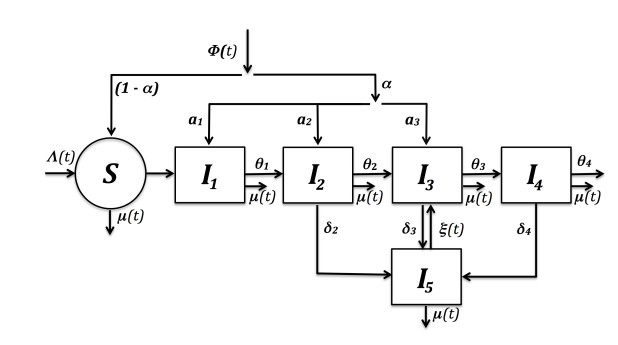
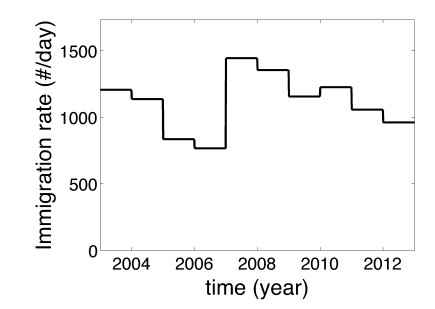
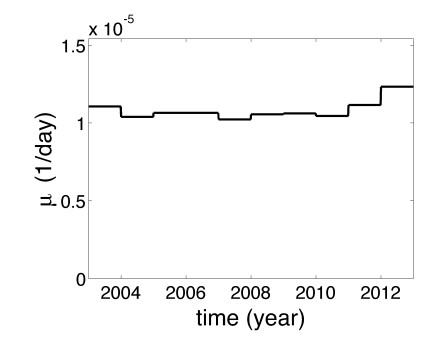
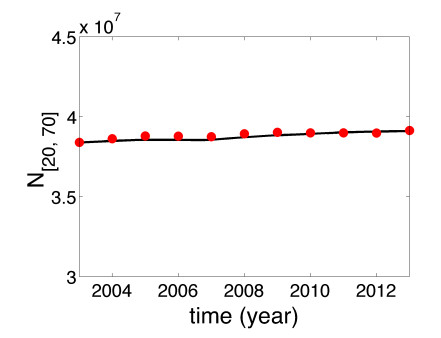
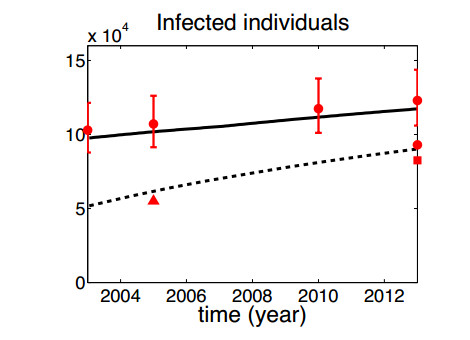
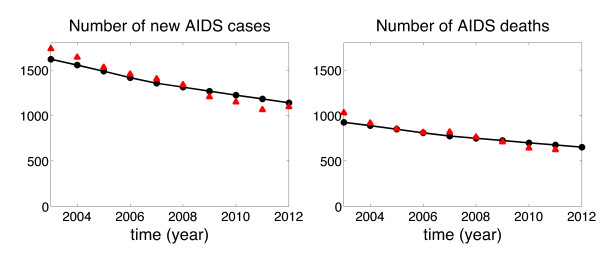
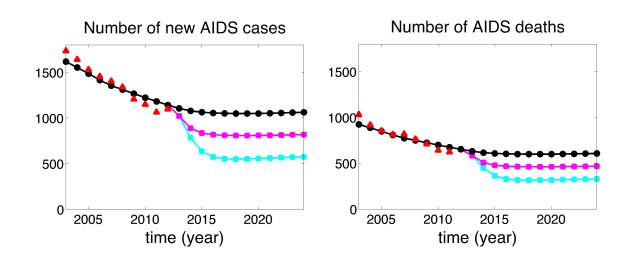
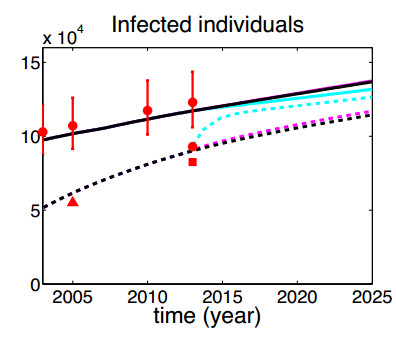
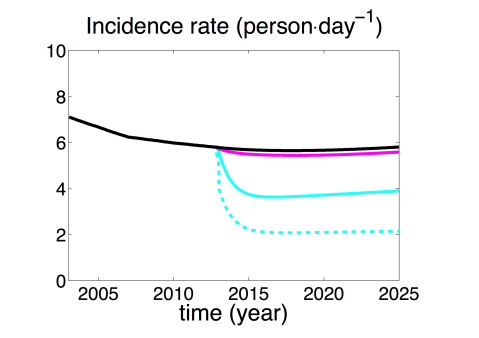
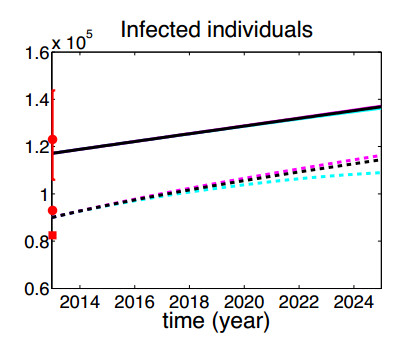
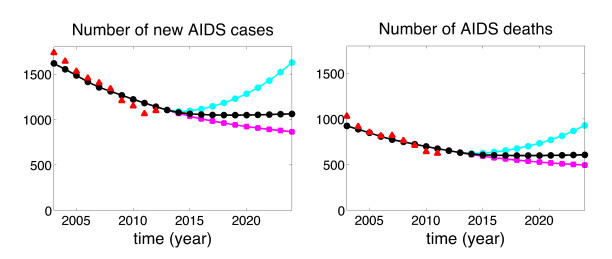
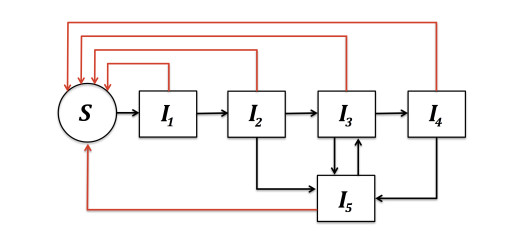


 DownLoad:
DownLoad: